Making The Most Of Your Fare Dollar

The Public Transport Council (PTC) has just announced the start of this year’s fare review exercise and any adjustment based on the current fare formula will be capped at 7%. This quantum is much higher than the 4.3% that we saw last year and one would naturally expect that the fare increase this year will be somewhat higher. But, extrapolating from the fare adjustment for last year, it is highly unlikely that any commuter will see his or her card fares increasing by more than 10-cents.
Being a regular commuter myself, I can understand that even when the fare adjustment is no more than 10 cents, daily users of public buses and MRT would be concerned about how the fare adjustment will impact their daily transport expenditure, especially since this would be the second consecutive year that fares will increase, after three years of fare reduction.
But I can assure you that when the Council meet to deliberate the operators’ fare applications, fare affordability – especially for those in the concession groups – will weigh heavily on the minds of each and every council member.
Singapore has done well so far in ensuring fare affordability. Studies by consulting firms McKinsey and Deloitte have ranked our fares among the lowest, compared with fares in many other international cities, and Singapore ranks well in terms of fare affordability. The Council takes our duty seriously and will strike a good balance between fare affordability and the financial sustainability of our public transport system.
Ensuring Sustainability
Besides affordability, PTC will also need to consider the escalating operating costs – due to high energy prices as well as rising manpower costs – to deliver a public transport system that is efficient, reliable and that serves the best interest of our commuters. This will be a tough balance.
While the public transport operators have reported mixed results in their last few rounds of financial reporting, it is also the case that both SMRT Trains and SBS Transit reported significant losses for their rail businesses in their most recent reports; SMRT Trains reported losses of $155 million, while SBS Transit reported losses in the region of “tens of millions”.
While our rail operators have been able to generate non-fare revenue from other areas, such as advertising and retail spaces, these are insufficient and at best cover 10% of the total operating costs for the railway network.
PTC will need to pay close attention to this widening gap between the cost of running the system and the revenue received, as it would become increasingly challenging for the operators to deliver a high level of service while sustaining such losses.
Almost all public transport systems around the world rely on a mix of government subsidies, fare revenue, and non-fare revenue. A natural question to ask is whether it would be fair for commuters to carry the full burden of the cost increases. Or should it be shared across commuters, the taxpayers and operators? Public transport is a basic necessity and it should be subsided to ensure affordability for all. In our case, taxpayers pay for the full cost of public transport civil infrastructure. Operating subsidies, in the form of government grants, also contribute towards the day-to-day running of our bus service as well as to the renewal of rail assets.
Reduce Transport Expenses With Better Planning
PTC tracks the affordability of public transport fares for both the average and low income households. Over the last five years, the proportion of household income that they spend on fares has been falling, meaning fares have become more affordable.

If we compare ourselves with the situation 5 years ago, we can be sure of two things. First, our average journey fare today is lower than that in 2015. For example, a train journey from Macpherson to Chinatown would have cost $1.48 in 2015, but the same journey today costs less, at just $1.29. Second, we are experiencing better service and connectivity with an expanded network from new bus services and train lines introduced, and with more trains and buses on the road,
And as we ponder over the quantum of this year’s fare increase, as commuters, we may also want to explore ways that we can potentially reduce the cost of our daily commute.
Save By Travelling Earlier
One easy way to save on our public transport expenditure is to consider travelling earlier. As part of the Fare Review Exercise in 2017, PTC had introduced the Morning Pre-Peak Fares. With the Morning Pre-Peak Fares, commuters can enjoy up to 50-cent savings when they tap-in before 7.45am at any rail station island-wide on weekdays. Since its implementation in 2017, about 336,000 commuters have benefited from lower fares.
Based on PTC’s analysis, about another 69,000 commuters can potentially benefit, by starting their day about 15 minutes earlier. If you currently travel during the morning peak hours, you may wish to consider setting your alarm slightly earlier on some mornings, and you may be surprised how much you can save!
Save By Making Use Of Monthly Passes
For commuters who travel very frequently, you may also consider buying a monthly travel pass that allows you to enjoy unlimited travel for a flat price. This means you can cap your monthly transport expenditure at the cost of the monthly travel pass.
Based on PTC’s analysis, about 38,000 commuters would actually be better off buying a monthly travel pass. If you are one of them, you could see savings as much as $10 each month, or even more.
For Commuters Still Using Cash
Besides monthly passes, some commuters have also shared that they spent more by paying cash fares on public transport, as they do not fancy pre-paid cards. The introduction of SimplyGo should be a welcome enhancement for this group of commuters who prefer to pay for trips only upon travelling. With SimplyGo, commuters simply link their bank or credit cards and consolidate their payments monthly. These ticketing innovations contribute to why Singapore has been ranked first among 100 international cities on the AD Little Urban Mobility Index.
Save By Taking Advantage Of Enhanced Transfer Rules
There is also a group of cost-conscious commuters who avoid making transfers on the transport network to save money. Some end up taking a single, albeit longer, train or bus only ride to get to their destinations. With the Enhanced Transfer Rules – which were introduced in 2018, they can cut down travelling time and costs by making transfers, made possible by the expanded MRT network. Commuters now have the flexibility to make multiple rail transfers or rail-bus-rail transfers without incurring an additional boarding charge.
Today, about 6,000 commuters already enjoy lower fares or shorter travel times with the implementation of the Enhanced Transfer Rules. However, anonymised card data tells us that up to 66,000 more stand to benefit from lower fares if they adjust their current travel routes to take advantage of the Enhanced Transfer Rules.
For example, a commuter travelling from Beauty World Station to Mattar Station can take the Downtown Line continuously and pay a fare of $1.71. His total journey time will be about 40 minutes. With the Enhanced Transfer Rules, he can consider making a rail-rail transfer between Rochor and Jalan Besar Stations, and pay a fare of only $1.55. His journey time will also be shortened by 5 minutes.
Scope To Reduce Transport Expenditure
That said, I recognise that the more “optimal routes” identified in the anonymised card data analysis may not be reflective of every commuter’s unique travel pattern and travel preference. Also, time, cost and fares may not be the only considerations that feature in our daily commute. Some commuters may prefer taking the bus because they can enjoy the view as they travel, while others may not like to make transfers because it involves walking and waiting.
Whatever the case may be, with our more extensive public transport network today, there are now considerable opportunities for us to save on our daily commute. With new rail lines in the pipeline, these opportunities will increase.
By: Vincent Chua
Public Transport Council member
The views and opinions expressed by Associate Professor Vincent Chua do not necessarily reflect the final decision of the Public Transport Council.
